The Plextor M3 (256GB) Review
by Kristian Vättö on April 5, 2012 3:05 AM ESTAnandTech Storage Bench 2011—Light Workload
Our new light workload actually has more write operations than read operations. The split is as follows: 372,630 reads and 459,709 writes. The relatively close read/write ratio does better mimic a typical light workload (although even lighter workloads would be far more read centric). The I/O breakdown is similar to the heavy workload at small IOs, however you'll notice that there are far fewer large IO transfers:
| AnandTech Storage Bench 2011—Light Workload IO Breakdown | ||||
| IO Size | % of Total | |||
| 4KB | 27% | |||
| 16KB | 8% | |||
| 32KB | 6% | |||
| 64KB | 5% | |||

Plextor M3 does equally well in our Light test as well. Only the Kingston HyperX is slightly faster due to its newer firmware; otherwise the performance of the M3 is similar to other high-end drives.
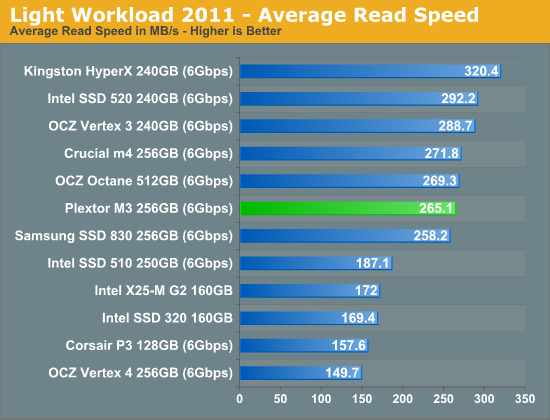
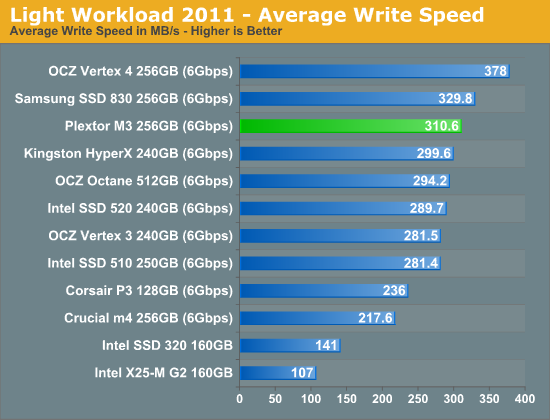
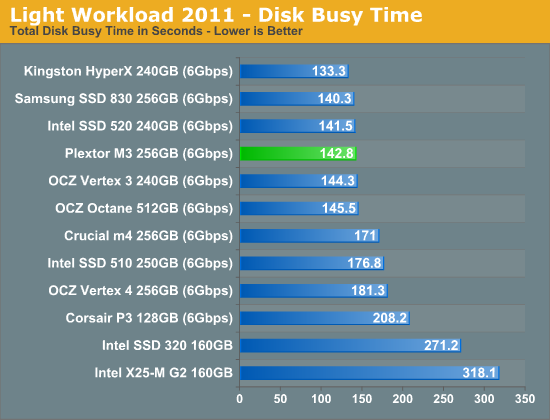
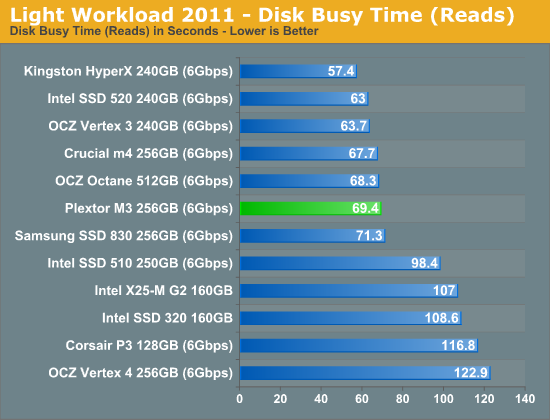
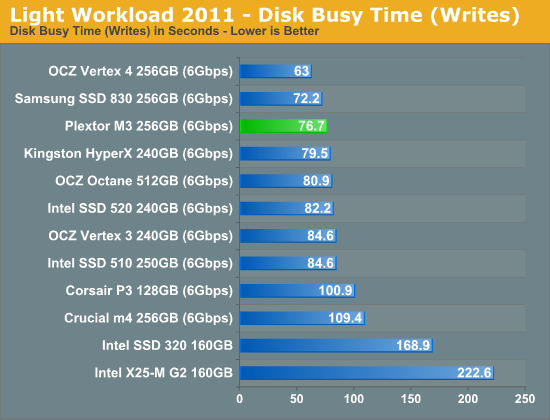










113 Comments
View All Comments
Kutark - Thursday, April 5, 2012 - link
I thought it kind of odd that the author hadn't heard of plextor until a couple of months ago. IMO basically anybody who had been building their own comps since the mid 90's should at least have heard of the brand.I wonder how old the author is. This kind of reminds me of when you mention Everquest in a conversation and the WOW generation has no clue what you're talking about.
BTW im not meaning to imply or say anything negative about the author, it just struck me as an odd thing to say.
Kutark - Thursday, April 5, 2012 - link
Well, had i read the comments i would seen that the author is 18, which explains quite a lot (again, not in a bad way)jabber - Thursday, April 5, 2012 - link
I thought the Plextor of old went bust years ago and the name was bought up by someone else?Basically standard goods with the Plextor name silkscreened on for 50% extra mark up.
I just threw out my trusty Plextor 712SA drive after about 8 years hard use.
Topweasel - Thursday, April 5, 2012 - link
No, as DVD burners became throwaway items (Sub $50) they started to offer re-branded parts, but higher quality ones. You could still tell from little things like the tray mechanism that they weren't Plextor. They also ran into a stumbling block with optics for DVD burners for the few they still manufactured. Since they are compared to the big ones, more of a boutique designer they had trouble at 16x+ of eeking out that last bit of quality. Which meant for their more expensive drives, they weren't king of the hill, meaning if reliability and not burning performance or burn quality were your concerns, then you wouldn't pay the extra amount. For the rebrands, they were actually price competitive even if they were like $5-$10 bucks more.Then came Blu-Ray drives. That did almost kill them. No one was/is buying them. Not like they would DVD drives. Internal drives also never hit the extremes that for example a DVD drive did at launch where they were $300-$400. So once again they were manufacturing expensive drives that no one was buying, and they couldn't even rebrand to make it more price competitive. That's why they went to SSD's, unlike OCZ that made the move because SSD's where much higher margin parts. Plextor did it to survive. But again they don't even have to make to many of these. Plextor makes its living as a low volume high quality high performance manufacturer. Even at their worse in 2008-2010, they were only just as good as everyone else. SSD's are just a product that they can produce that performance actually matters and higher prices are acceptable.
But no Plextor today is the same Plextor of old. Just with a new focus, but same goal.
Beenthere - Thursday, April 5, 2012 - link
Plextor has the potential to sell some decent SSDs. I think the M3 Pro should be the base model with the 3M pricing and Plextor should work on a true Pro model. The Pro pricing is unacceptable and the M3 performance lacking IMO.GrizzledYoungMan - Thursday, April 5, 2012 - link
Any reason to use 10.2 over 10.6?Kristian Vättö - Thursday, April 5, 2012 - link
From a user's standpoint, no. For reviews it's important to use the same set of software and drivers as an updated version may impact performance. In other words, we would have to test all SSDs again if we updated Intel RST to 10.6. That's why we are sticking with 10.2, at least for now.Maiyr - Thursday, April 5, 2012 - link
"Plextor as a brand is probably a new acquaintance for most people and I have to admit that I had not heard of Plextor until a couple of months ago."I must be getting old. That just seems crazy to me.
Maiyr
jwilliams4200 - Thursday, April 5, 2012 - link
With regards to idle power, the 256GB Crucial m4 shows half the idle power of the 256GB Vertex 4 in your chart, but they both have the same amount of synchronous flash.And since they are both using a Marvell controller (the V4 has a rebadged Marvell 88SS9187, the m4 has an 88SS9174), it is clear that the biggest factor in idle power consumption is NOT the amount and type of flash memory.
Kristian Vättö - Friday, April 6, 2012 - link
You really need some proof that the Indilinx Everest 2 is just a rebadged Marvell 88SS9187, I've seen nothing that indicates so.Of course the controller draws power as well and it can lead to high power consumption, so NAND is definitely not the only factor - I was only pointing out that Toggle NAND is more power efficient. It's possible that a future firmware update will decrease the power consumption of Vertex 4, that happened with Vertex 3 at least.